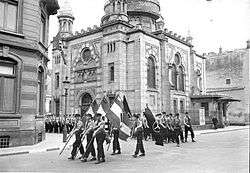The Holocaust in Luxembourg
The Holocaust in Luxembourg refers to the persecution and near-annihilation of the 3,500-strong Jewish population of Luxembourg begun shortly after the start of the German occupation during World War II, when the country was officially incorporated into Nazi Germany. The persecution lasted until October 1941, when the Germans declared the territory to be free of Jews who had been deported to extermination camps and ghettos in Eastern Europe.

History
Before the war, Luxembourg had a population of about 3,500 Jews, many of them newly arrived in the country to escape persecution in Germany.[1] The Nuremberg Laws, which had applied in Germany since 1935, were enforced in Luxembourg from September 1940 and Jews were encouraged to leave the country for Vichy France.[1] Emigration was forbidden in October 1941, but not before nearly 2,500 had fled.[1] In practice they were little better off in Vichy France, and many of those who left were later deported and killed. From September 1941, all Jews in Luxembourg were forced to wear the yellow Star of David badge to identify them.[2]
From October 1941, Nazi authorities began to deport the around 800 remaining Jews from Luxembourg to Łódź Ghetto and the concentration camps at Theresienstadt and Auschwitz.[1] Around 700 were deported from the Transit Camp at Fuenfbrunnen in Ulflingen in the north of Luxembourg.[1]
Luxembourg was declared "Judenfrei" ("cleansed of Jews") except for those in hiding[2] on 19 October 1941.[3] Of the original Jewish population of Luxembourg, only 36 are known to have survived the war.[1]
See also
- The Holocaust
- Luxembourg in World War II
- Luxembourgish Resistance
References
- "Luxembourg". United States Holocaust Memorial Museum. Retrieved 11 May 2013.
- "The Destruction of the Jews of Luxembourg". Holocaust Education and Archive Research Team. Retrieved 11 May 2013.
- "Commémoration de la Shoah au Luxembourg". Government.lu. 3 July 2005. Archived from the original on 9 May 2012. Retrieved 11 May 2013.
Further reading
- Artuso, Vincent (October 2012). "Des excuses, mais au nom de qui? L'administration luxembourgeoise et la Shoah". Forum (322): 9–11.
- Cerf, Paul (1986). L'étoile juive au Luxembourg. Luxembourg: RTL.
- Clesse, René (1991). "Die Natur is gnädiger als die Menschen". Ons Stad. 36: 22–25.
- Clesse, René (2002). "Shoah in Luxemburg". Ons Stad. 71: 18–19.
- Hoffmann, Serge (1996). "Luxemburg - Asyl und Gastfreundschaft in einem kleinen Land". In Benz, Wolfgang; Wetzel, Juliane (eds.). Solidarität und Hilfe für Juden während der NS-Zeit. Regionalstudien I: Polen, Rumänien, Griechenland, Luxemburg, Norwegen, Schweiz. Berlin: Metropol-Verlag. pp. 187–204. ISBN 9783926893437.
- Zariz, Ruth (1993). "The Jews of Luxembourg during the Second World War". Holocaust and Genocide Studies. 7 (1): 51–66. doi:10.1093/hgs/7.1.51.
External links
| Wikimedia Commons has media related to The Holocaust in Luxembourg. |
- Luxembourg at United States Holocaust Memorial Museum (USHMM)
- Luxembourg at European Holocaust Research Infrastructure (EHRI)
- Memoshoah.lu at MemoShoah association